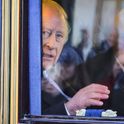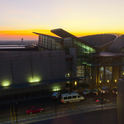Read more: after Ukraine, are the Baltics in Putin's sights?
With the angry crowd wielding Russian flags, it looks just like a scene from Ukraine’s eastern Donbass region. Men in balaclavas storm a local government building and remove the flags from its façade. Except this time, they are the Latvian and EU flags, and the setting is not Ukraine but Latvia’s eastern region of Latgale, near the Russian Border. This is the opening of World War Three: Inside the War Room, which was broadcast on BBC Two tonight. In it, ten political, diplomatic and military figures war-game an imagined scenario in which Russia becomes militarily involved with Latvia and Estonia.
The one-hour programme jumps between fake documentary scenes set in Latvia, and scenes set in the “war room,” where the ten figures debate how to respond to Russia’s hypothetical moves and, ultimately, whether to engage in nuclear warfare. This makes for a charged 59 minutes of midweek television yet, given the current tensions along NATO’s eastern edge, the BBC’s decision to broadcast it is surprising.
The programme reflects genuine concerns about Moscow’s ambitions in the Baltic region since Russia annexed Crimea in March 2014. Some observers have warned that the three Baltic States—Estonia, Latvia and Lithuania—might be next. (Note that the first two of these countries have large ethnic Russian minorities). In an interview a year ago, Lithuania’s defence minister Juozas Olekas told me that his country is “in a different situation” to Ukraine since it joined NATO in 2004, and so perhaps Russia will stay away. Still, as the BBC programme shows in its compelling “war room” scenes, it is unclear exactly how NATO members would or, in practical terms, could respond to a Russian attack on one of the Baltic States. A focus of the next NATO summit, in Warsaw in July, will be strengthening the Alliance’s presence along its eastern flank.
Strategists have been thinking ahead, imaging possible scenarios in the Baltic. For instance, a Finnish magazine outlined three hypothetical storylines involving Russian attacks on Finland’s Åland Islands, the Swedish island of Gotland, and the city of Narva, on Estonia’s border with Russia (the article can be read in English here). Meanwhile, there have been dubious efforts to depict Latgale as a potential Latvian Donbass, and shadowy online calls to establish a “Latgalian People’s Republic” (like the Republics of Donetsk or Luhansk), which the Latvian security services deemed to have been fabricated from outside Latgale.
Hypothetical scenarios are one thing, the BBC’s programme is another. Inside the War Room is not a documentary about Moscow’s influence in the Baltic States, featuring interviews with Latgalians (many of whom resent being stereotyped as disloyal to Latvia). Instead, it sets a violent takeover in a living, breathing region of the world where speakers of Russian, Latvian and the local Latgalian (which some consider a dialect of Latvian) nestle side by side. It is not like in the civil service FastStream exam I sat as a student, which involved hypothetical sudden developments in a crisis-ridden country with a made-up name; it is closely connected to the real world.
Even before its broadcast, and with almost no details about its content, the programme has raised eyebrows in Latvia, prompting heated comments online. Jnis Srts, director of the Riga-based NATO Strategic Communications Centre of Excellence (STRATCOM) commented that the genre of entertainment should not be confused with reality. The Russian media has picked up the BBC programme too. TV Zvezda, a television channel run by Russia’s ministry of defence, announced it in an article with the headline: “Britain will not reply to Russia’s nuclear strike—Daily Mail.” More broadly, by portraying Russia as fearsome, Latvia’s ethnic Russians as separatists, Riga as helpless and its Western allies as hesitant, the programme inadvertedly echoes some of the Kremlin’s narratives.
Video footage is a particularly sensitive matter, in the context of the use and abuse of images during the conflict in Ukraine. The BBC programme is not a documentary, but could be assumed to be so, or depicted as one. Its news-like scenes set in Latvia and the Baltic States, complete with authoritative voiceover in BBC English, could easily be construed as news reports. Some viewers will say that World War Three: Inside the War Room is just a television programme, yet already its repercussions have been wider.
With the angry crowd wielding Russian flags, it looks just like a scene from Ukraine’s eastern Donbass region. Men in balaclavas storm a local government building and remove the flags from its façade. Except this time, they are the Latvian and EU flags, and the setting is not Ukraine but Latvia’s eastern region of Latgale, near the Russian Border. This is the opening of World War Three: Inside the War Room, which was broadcast on BBC Two tonight. In it, ten political, diplomatic and military figures war-game an imagined scenario in which Russia becomes militarily involved with Latvia and Estonia.
The one-hour programme jumps between fake documentary scenes set in Latvia, and scenes set in the “war room,” where the ten figures debate how to respond to Russia’s hypothetical moves and, ultimately, whether to engage in nuclear warfare. This makes for a charged 59 minutes of midweek television yet, given the current tensions along NATO’s eastern edge, the BBC’s decision to broadcast it is surprising.
The programme reflects genuine concerns about Moscow’s ambitions in the Baltic region since Russia annexed Crimea in March 2014. Some observers have warned that the three Baltic States—Estonia, Latvia and Lithuania—might be next. (Note that the first two of these countries have large ethnic Russian minorities). In an interview a year ago, Lithuania’s defence minister Juozas Olekas told me that his country is “in a different situation” to Ukraine since it joined NATO in 2004, and so perhaps Russia will stay away. Still, as the BBC programme shows in its compelling “war room” scenes, it is unclear exactly how NATO members would or, in practical terms, could respond to a Russian attack on one of the Baltic States. A focus of the next NATO summit, in Warsaw in July, will be strengthening the Alliance’s presence along its eastern flank.
Strategists have been thinking ahead, imaging possible scenarios in the Baltic. For instance, a Finnish magazine outlined three hypothetical storylines involving Russian attacks on Finland’s Åland Islands, the Swedish island of Gotland, and the city of Narva, on Estonia’s border with Russia (the article can be read in English here). Meanwhile, there have been dubious efforts to depict Latgale as a potential Latvian Donbass, and shadowy online calls to establish a “Latgalian People’s Republic” (like the Republics of Donetsk or Luhansk), which the Latvian security services deemed to have been fabricated from outside Latgale.
Hypothetical scenarios are one thing, the BBC’s programme is another. Inside the War Room is not a documentary about Moscow’s influence in the Baltic States, featuring interviews with Latgalians (many of whom resent being stereotyped as disloyal to Latvia). Instead, it sets a violent takeover in a living, breathing region of the world where speakers of Russian, Latvian and the local Latgalian (which some consider a dialect of Latvian) nestle side by side. It is not like in the civil service FastStream exam I sat as a student, which involved hypothetical sudden developments in a crisis-ridden country with a made-up name; it is closely connected to the real world.
Even before its broadcast, and with almost no details about its content, the programme has raised eyebrows in Latvia, prompting heated comments online. Jnis Srts, director of the Riga-based NATO Strategic Communications Centre of Excellence (STRATCOM) commented that the genre of entertainment should not be confused with reality. The Russian media has picked up the BBC programme too. TV Zvezda, a television channel run by Russia’s ministry of defence, announced it in an article with the headline: “Britain will not reply to Russia’s nuclear strike—Daily Mail.” More broadly, by portraying Russia as fearsome, Latvia’s ethnic Russians as separatists, Riga as helpless and its Western allies as hesitant, the programme inadvertedly echoes some of the Kremlin’s narratives.
Video footage is a particularly sensitive matter, in the context of the use and abuse of images during the conflict in Ukraine. The BBC programme is not a documentary, but could be assumed to be so, or depicted as one. Its news-like scenes set in Latvia and the Baltic States, complete with authoritative voiceover in BBC English, could easily be construed as news reports. Some viewers will say that World War Three: Inside the War Room is just a television programme, yet already its repercussions have been wider.












